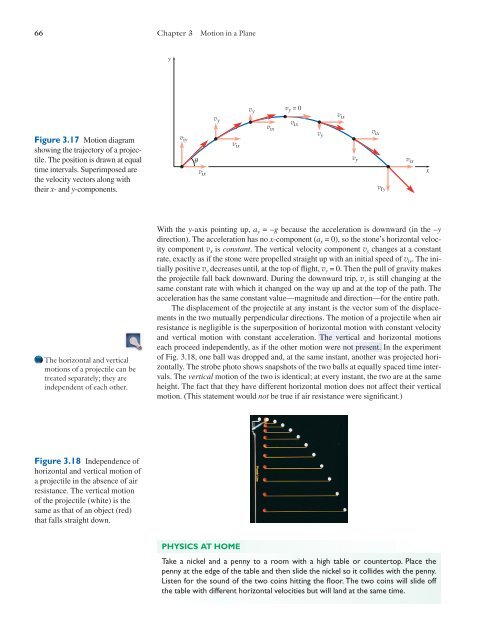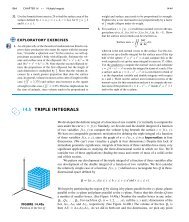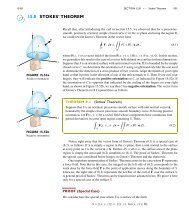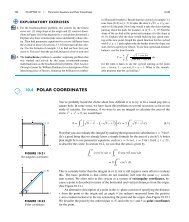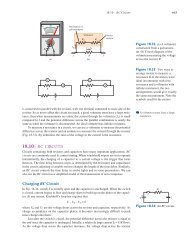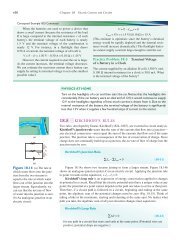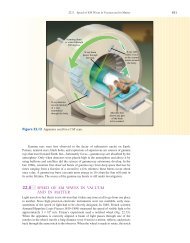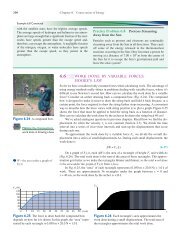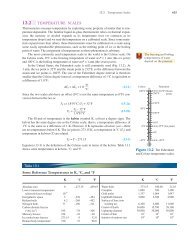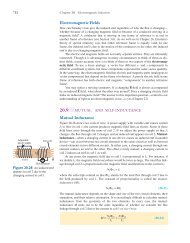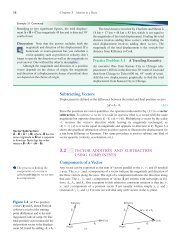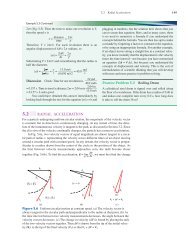Motion of Projectiles
Motion of Projectiles
Motion of Projectiles
You also want an ePaper? Increase the reach of your titles
YUMPU automatically turns print PDFs into web optimized ePapers that Google loves.
66 Chapter 3 <strong>Motion</strong> in a Plane<br />
y<br />
v y<br />
v y<br />
v y = 0<br />
Figure 3.17 <strong>Motion</strong> diagram<br />
showing the trajectory <strong>of</strong> a projectile.<br />
The position is drawn at equal<br />
time intervals. Superimposed are<br />
the velocity vectors along with<br />
their x- and y-components.<br />
v iy<br />
v ix<br />
v<br />
v ix ix<br />
v v y ix<br />
v ix<br />
θ<br />
v y<br />
v ix<br />
v ix<br />
v fy<br />
x<br />
The horizontal and vertical<br />
motions <strong>of</strong> a projectile can be<br />
treated separately; they are<br />
independent <strong>of</strong> each other.<br />
With the y-axis pointing up, a y = –g because the acceleration is downward (in the –y<br />
direction). The acceleration has no x-component (a x = 0), so the stone’s horizontal velocity<br />
component v x is constant. The vertical velocity component v y changes at a constant<br />
rate, exactly as if the stone were propelled straight up with an initial speed <strong>of</strong> v iy . The initially<br />
positive v y decreases until, at the top <strong>of</strong> flight, v y = 0. Then the pull <strong>of</strong> gravity makes<br />
the projectile fall back downward. During the downward trip, v y is still changing at the<br />
same constant rate with which it changed on the way up and at the top <strong>of</strong> the path. The<br />
acceleration has the same constant value—magnitude and direction—for the entire path.<br />
The displacement <strong>of</strong> the projectile at any instant is the vector sum <strong>of</strong> the displacements<br />
in the two mutually perpendicular directions. The motion <strong>of</strong> a projectile when air<br />
resistance is negligible is the superposition <strong>of</strong> horizontal motion with constant velocity<br />
and vertical motion with constant acceleration. The vertical and horizontal motions<br />
each proceed independently, as if the other motion were not present. In the experiment<br />
<strong>of</strong> Fig. 3.18, one ball was dropped and, at the same instant, another was projected horizontally.<br />
The strobe photo shows snapshots <strong>of</strong> the two balls at equally spaced time intervals.<br />
The vertical motion <strong>of</strong> the two is identical; at every instant, the two are at the same<br />
height. The fact that they have different horizontal motion does not affect their vertical<br />
motion. (This statement would not be true if air resistance were significant.)<br />
Figure 3.18 Independence <strong>of</strong><br />
horizontal and vertical motion <strong>of</strong><br />
a projectile in the absence <strong>of</strong> air<br />
resistance. The vertical motion<br />
<strong>of</strong> the projectile (white) is the<br />
same as that <strong>of</strong> an object (red)<br />
that falls straight down.<br />
PHYSICS AT HOME<br />
Take a nickel and a penny to a room with a high table or countertop. Place the<br />
penny at the edge <strong>of</strong> the table and then slide the nickel so it collides with the penny.<br />
Listen for the sound <strong>of</strong> the two coins hitting the floor. The two coins will slide <strong>of</strong>f<br />
the table with different horizontal velocities but will land at the same time.


